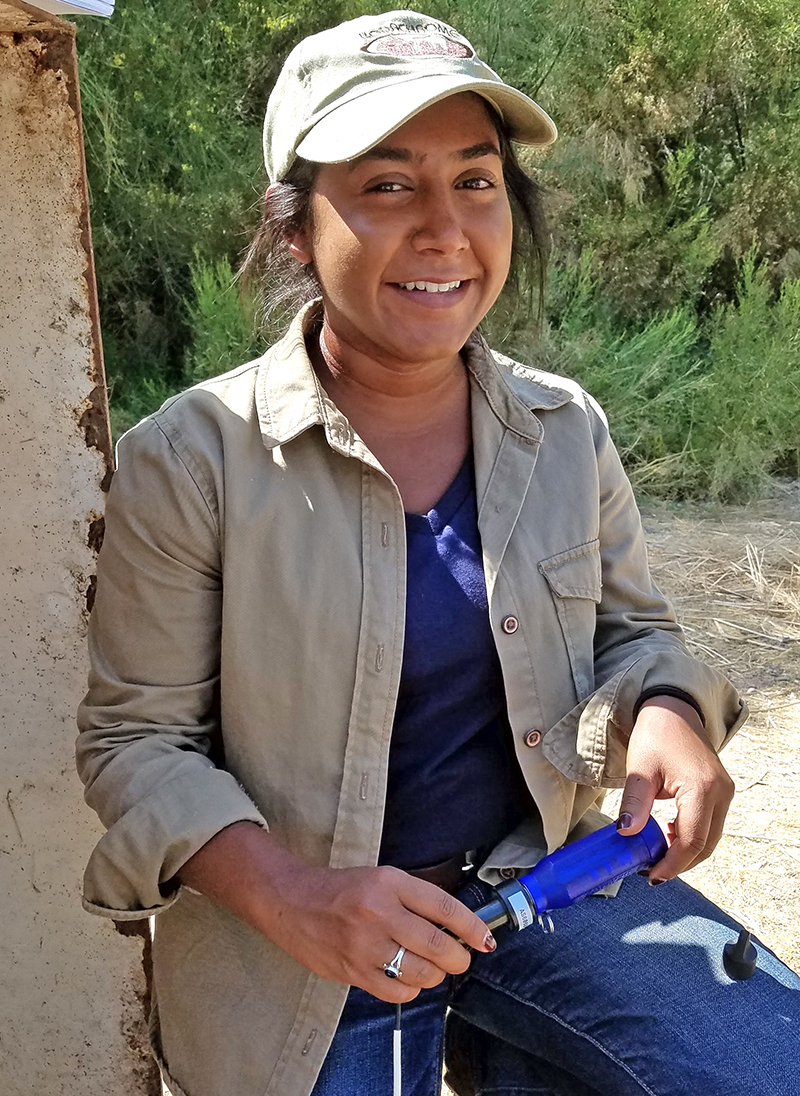— by Mekha Pereira

The Leonard Halpenny Internship was an incredibly unique opportunity to work with four different companies in Tucson. I had the chance to spend time with two consulting firms, one municipal water provider, and one federal agency. Gaining exposure to the diversity of work possible within the field of hydrology is what interested me most when applying to this internship, and I am so grateful to have had this experience as an undergraduate student.
I began my internship at Tucson Water working with Dick Thompson. He is great educator who taught me a lot about water management practices in Tucson. I became involved in a project studying the recharge of improved quality effluent discharged from the Agua Nueva Water Reclamation Facility to the Lower Santa Cruz River. Dick, Margaret Snyder, and I had a lot of fun with our trips to the river (The Mighty Santa Cruz as Dick likes to call it!), where we monitored a 1-mile stretch fed by effluent. We took regular flow measurements and created a temporary setup for monitoring water levels by installing divers in the streambed. Being part of an ongoing field study, I gained experience using various types of equipment and learned the importance of detailed and consistent note taking in field work. Through Dick’s encouragement, I shared what we learned about the nature of effluent flow in the river at the 2016 AHS symposium, where I received helpful feedback, and have continued to work on this project for my senior capstone in hydrology. This was the first project in hydrology that I took on outside of the classroom and am thankful that I was able to do it with Tucson Water professionals who really encourage student involvement.
The next agency I visited was the USGS, where Rob Carruth introduced me to work being done to estimate groundwater storage change in the Tucson AMA. I worked with another hydrology student, Libby Kahler, who taught me about the topic of gravity methods to study groundwater — which was completely new to me. We organized several years of gravity survey results to be analyzed to find changes in groundwater storage over time. Libby also showed me how to take measurements with the gravimeter and learning about a new instrument was particularly interesting. I also spent a day with Emmet McGuire in the field office and was lucky to be working with him on a summer day when an intense monsoon storm came through. We went to Pantano Wash where I got to see how a flow measurement could safely be taken from a bridge during a monsoon flow. The usually dry wash was flowing with nearly 6 feet of water at its deepest point, and seeing the setup for lowering a flowmeter from a bridge was very impressive. USGS data is a resource I use often in coursework, so I really appreciated being able to spend time here.
The third company I visited was Montgomery & Associates, where I worked with Gary Woodard. As an applied math major, working with Gary was an especially valuable experience because he gave me the opportunity to combine my interest in statistics with hydrology. We worked on various projects including determining the cost breakdown of indoor water use activities, verifying the water use efficiency of an improved technology washer, and looking at trends in pool removal and determining the water demand of having a swimming pool. With each new topic, he took the time to carefully explain the study motivation to me so I would better understand the statistics I needed to develop. I learned many new tricks in Excel not only dealing with computation but more importantly for managing and consolidating large amounts of data from County databases. I also learned about how to most appropriately visually display the results of these analyses so they would be intuitive and meaningful to a wider audience. After spending time at Montgomery & Associates, I developed more of an interest in water policy analysis and have pursued further study in this area by taking an econometrics course.
I ended my internship at Clear Creek Associates where I worked under Greg Hess. On my first day, he introduced me to the company but also encouraged me to take some time to explore the historic building and area home to the office, which is a great work environment to be around. He emphasized that he wanted me to leave my experience with a skill that I could apply to my first job in hydrology. I was tasked with looking at water level changes in the Tucson basin by pulling records from ADWR’s GWSI database. Once I found where water levels were changing most in recent years, I looked at the 55 Well Registry to determine whether the trends were likely due to changes in pumping. Navigating large state databases can be overwhelming but with some initial help from Kristi Sagar, I became well acquainted with the sites and am now comfortable extracting the information needed from the large amount available. I have since used these tools in coursework and imagine that if I do work in southwest hydrology, these databases will be a regular reference.
I want to thank all the participating companies for this wonderful opportunity. I met so many experts in the hydrology community in Tucson who took the time to make sure I learned something valuable in my time at their company. These 200 hours were one of the best learning experiences of my college career and I left the internship excited to begin working in a field that I can now even more confidently say is the right fit for me. Thank you much to AHS for providing this opportunity — I had such a great time!

